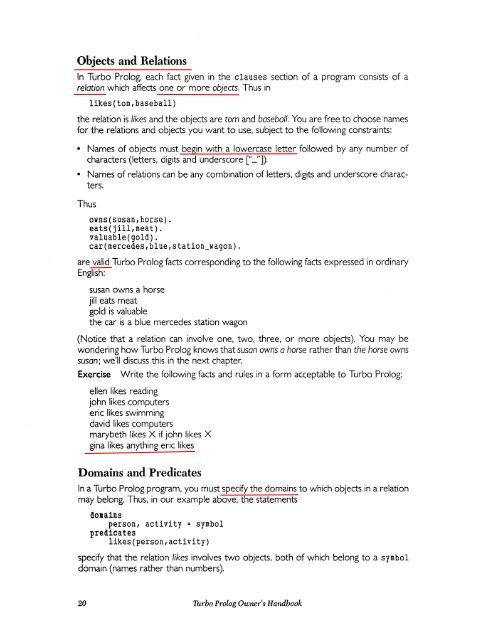Turbo Prolog
Turbo Prolog
Turbo Prolog
You also want an ePaper? Increase the reach of your titles
YUMPU automatically turns print PDFs into web optimized ePapers that Google loves.
Objects and Relations<br />
In <strong>Turbo</strong> <strong>Prolog</strong>, each fact given in the clauses section of a program consists of a<br />
relation which affects one or more objects. Thus in<br />
likes(tom,baseball)<br />
the relation is likes and the objects are tom and baseball. You are free to choose names<br />
for the relations and objects you want to use, subject to the following constraints:<br />
• Names of objects must begin with a lowercase letter followed by any number of<br />
characters (letters, digits and underscore ["_"]).<br />
• Names of relations can be any combination of letters, digits and underscore characters.<br />
Thus<br />
owns(susan,horse).<br />
eats(jill,meat).<br />
valuable(gold).<br />
car(mercedes,blue,station_wagon).<br />
are valid <strong>Turbo</strong> <strong>Prolog</strong> facts corresponding to the following facts expressed in ordinary<br />
English:<br />
susan owns a horse<br />
jill eats meat<br />
gold is valuable<br />
the car is a blue mercedes station wagon<br />
(Notice that a relation can involve one, two, three, or more objects). You may be<br />
wondering how <strong>Turbo</strong> <strong>Prolog</strong> knows that susan owns a horse rather than the horse owns<br />
susan; we'll discuss this in the next chapter.<br />
Exercise Write the following facts and rules in a form acceptable to <strong>Turbo</strong> <strong>Prolog</strong>:<br />
ellen likes reading<br />
john likes computers<br />
eric likes swimming<br />
david likes computers<br />
marybeth likes X if john likes X<br />
gina likes anything eric likes<br />
Domains and Predicates<br />
In a <strong>Turbo</strong> <strong>Prolog</strong> program, you must specify the domains to which objects in a relation<br />
may belong. Thus, in our example above, the statements<br />
domains<br />
person, activity = symbol<br />
predicates<br />
likes(person,activity)<br />
specify that the relation likes involves two objects, both of which belong to a symbol<br />
domain (names rather than numbers).<br />
20 <strong>Turbo</strong> <strong>Prolog</strong> Owner's Handbook


